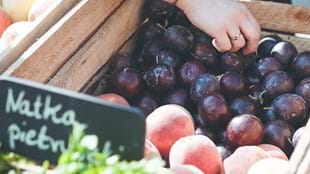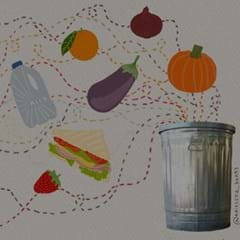Once, before industrialized farming, we all ate “organically”. There were no such things as inorganic pesticides, fertilizers, irradiation, solvents, or synthetic food additives. As a movement, the conversation around organics only took off once industrial farming emerged in the 20th century and the distinction could be drawn. The first books were published in the mid-1940s (the term “organic farming” was coined in 1939). The term “organic food” barely existed before the mid-1960s, then it skyrocketed. A second big jump happened in the early 2000s.
Organics are fashionable – but there isn’t much conventional research to “prove” a diet high in organics is actually better for you nutritionally. Like all areas of diet and nutrition, the long-term, double-blind, randomized, controlled trials necessary to prove it are difficult to conduct.
One area where there has been some scientific agreement, however, is that organics don’t have as much pesticide residue as is found in conventionally-farmed food. A 2014 meta-analysis found that the latter was four times more likely to have pesticide residue than crops grown organically. Research suggests that pesticide exposure, even within legal limits, interferes with the body in subtle ways, including fertility and hormone balance.
Conventionally-farmed food is four times more likely to have pesticide residue than crops grown organically.
A recent study in the Journal of the American Medical Association (JAMA) Internal Medicine was the first to link pesticides with reduced fertility outcomes. In the Harvard University EARTH study, women undergoing fertility treatment who reported eating more than 2.2 servings per day of the 14 conventionally grown fruits and vegetables with the highest pesticide residues had a 26 percent lower probability of a successful pregnancy compared to those who ate less than one serving a day (women who reported buying organic were excluded).
Higher-residue foods included apples, strawberries, grapes, leafy greens, sweet capsicum or bell peppers and strawberries. Low-residue foods included onions, sweet corn, grapefruit, avocados and cabbage.
The researchers found that replacing just one serving of high-pesticide residue produce with a low-residue one could increase the probability of a successful pregnancy by an astonishing 88 percent, and there was a similar association with male reproductive health. The researchers admitted they were surprised by the results; the senior author told CNN that he was initially positive they would find “absolutely no relation” between exposure to pesticide residues in fruits and vegetables and adverse reproductive outcomes.
“While I think we need more studies to confirm or refute our findings, I am now more willing to pay the extra money for organic apples and strawberries than I was when we started this project,” he said.
So more research is needed, but there are other reasons to eat organic. Anecdotally, many people report that an organic carrot just tastes more … carroty. They choose organic for that reason, as well as to reduce their total synthetic pesticide exposure, support local farmers, and encourage less damaging global farming practices. They’re willing to pay more for those carrots, too; eating organically can often be wealthy person’s game due to lower yields and higher labor costs in its production.
True, not everyone has $250 a week to spend on groceries, and it’s difficult to eat 100 percent organic because of the cost, seasonal and geographical restrictions on production, and the desire to consider other environmental factors such as food miles and the effect of transit on food quality.
But if you want to keep an eye on pesticides, seek out the US Food and Drug Administration’s annual Pesticide Residue Monitoring Program report, indicating violations of currently allowable pesticide levels – which doesn’t necessarily mean wholly safe. The pesticides detected in tests run by the FDA are known to cause cancer, birth defects, nervous system and brain damage, and developmental problems in children.
In 2016, pesticide limit violations were found in 2 percent of milk samples, 16.2 percent of egg samples, and 27.1 percent of honey samples. When testing for herbicide glyphosate, non-violative levels of glyphosate were found in 63.1 percent of the corn samples and 67 percent of the soybean samples. Meanwhile, acid herbicide residue levels were found in 891 samples, including six grain crops (corn, soybeans, barley, rice, wheat, and oats) and eight root crops (potatoes, turnips, sugar beets, peanuts, carrots, radishes, beets, and sweet potatoes).
So what’s the trade-off? If you’re concerned about pesticide residue, what are the foods on your plate that you should definitely try to replace with organic?
Foods pinpointed in the Harvard study as having the highest pesticide residue are very similar to the Environmental Working Group’s infamous annual pesticide-residue list, the “Dirty Dozen and the Clean Fifteen”. The Dirty Dozen contains strawberries, spinach, nectarines, apples, grapes, peaches, cherries, pears, tomatoes, celery, potatoes, and capsicum or sweet bell peppers.
The Clean Fifteen are avocados, sweetcorn, pineapples, cabbage, onions, sweet frozen peas, papayas, asparagus, mangos, eggplant, honeydew melon, kiwifruit, cantaloupe, cauliflower and broccoli. So if you’re saving your food dollars, these are the “safest” commercially grown fruits and vegetables to eat when it comes to pesticide levels.
THE DIRTY DOZEN
Strawberries, spinach, nectarines, apples, grapes, peaches, cherries, pears, tomatoes, celery, potatoes, and capsicum or sweet bell peppers.
These commercially-grown fruit and veges are likely to have to have the most pesticide residue, so it’s a good idea to shop for organic options where possible.
THE CLEAN FIFTEEN
Avocados, sweetcorn, pineapples, cabbage, onions, sweet frozen peas, papayas, asparagus, mangos, eggplant, honeydew melon, kiwifruit, cantaloupe, cauliflower and broccoli.
When it comes to pesticide levels these are the “safest” commercially grown fruits and vegetables to eat.
Levels of pesticides can also depend on where they’re grown. Check the country of origin label, as some countries have higher limits, or regularly flout the laws of the country they’re being imported into.
After produce, grains are the most likely to have high levels of pesticide residue, with wheat products and breakfast cereals topping the list, and oat and pasta products the least likely. Fish from the ocean are more likely to be high in heavy metals than in pesticides, though many freshwater fish are exposed to high levels of pesticides from contaminated water.
Meat is another matter. The Environmental Protection Agency advises that meat is contaminated with higher levels of pesticides than any plant food. As well as being dosed with antibiotics and other drugs, beef can store pesticides from exposure to crop foods. As organisms at the top of the food chain, synthetics accumulate in their fat (and resultant dairy products) over time, as they do with humans.
Additionally, levels of allowable pesticides can be much higher for animal feed than foods for human consumption. For glyphosate, it can be more than 100 times as much, and the amount of glyphosate allowed in red meat is more than 20 times the allowable level for most plant crops.
Naomi Arnold is a New Zealand-based author and writer specializing in environmental and health issues.








